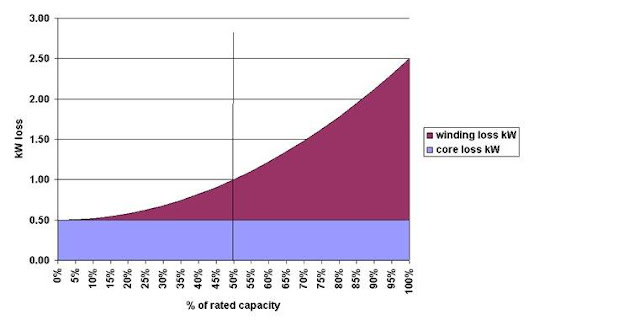The transformer is a vital link between the load and the supply. The efficiency of the transformer is very important in view of energy saving. The transformer supplies the required power to the load at the specified voltage. Various loads are connected to the transformer, and the loading on the transformer varies according to the running hours of the different loads connected to the secondary of the transformer. The efficiency of the transformer varies when the loading on the transformer is increased or decreased.

Under the no-load condition, the transformer draws only magnetizing current, and the current represents the core loss. The primary and secondary currents increase with increased loading on the secondary of the transformer. The output power of the transformer can’t be equal to the input power because of the no-load core losses and the copper loss. A certain amount of electrical energy is lost in the form of the heat. The higher the losses, the lesser the efficiency of the transformer.
The efficiency of the transformer is defined as the ratio of output power to input power at any load.

The efficiency of the transformer can be expressed in terms of output power and losses.

Efficiency η can be expressed in percentages as

Losses in Transformer
The losses in a transformer at given loads must be calculated to determine the efficiency of the transformer. The following losses occur in a transformer.
1. No load losses
2. Primary Copper loss
3. Secondary Copper loss
4. Stray loss
5. Dielectric loss
No Load or Iron/ core Loss:
No load loss can be categorized into – The Eddy current loss and Hysteresis loss.
The eddy current loss occurs because of the induced voltage in the steel parts, and the eddy current starts flowing in the steel parts of the core. The eddy current loss is the power loss that occurs in the lamination. The eddy current loss can be expressed by following mathematical expressions.

t is the thickness of the lamination. The use of thin lamination can reduce the eddy current loss.
The hysteresis loss occurs because of cyclic magnetization of the dipoles. The energy required to align the dipoles in the core is dissipated as heat energy.
The hysteresis loss can be expressed as;

The total core loss is the sum of eddy current loss plus hysteresis loss. The core loss can be calculated by the open circuit test of the transformer.
Primary and secondary Copper Loss or Load Losses :
The copper loss in the transformer is load-dependent, which increases with increased loading on the transformer.

The primary and secondary copper loss occurs due to the flow of electric current in the winding. The heat loss(I2 R) occurs in the winding because the winding has a certain resistance. The total copper loss is ;

A short circuit test calculates the copper loss. The resistance must be corrected for the operating temperature of the transformer. The temperature of the winding resistance should be corrected to 75 °C. The corrected resistance at 75 °C is;

Stray Loss:
Stray loss occurs due to leakage flux in the transformer. When the transformer is at full load, some flux leaks and gets linked to the other parts of the transformer.
Dielectric Loss:
Dielectric loss occurs in the insulation of the transformer. The tanδ test can obtain the loss.
Efficiency Calculation of the Transformer:
The major losses in the transformer are copper loss and core loss. The core loss is voltage and frequency-dependent; the loss remains more or less constant for the constant voltage and frequency. The core loss is also known as constant loss. It is independent of the load, and the core loss is fairly constant for 0-100 % loading on the transformer.
The copper loss of the transformer depends on the loading on the transformer, and it increases as the loading on the transformer is increased. The copper loss is known as variable loss.
Let the transformer’s KVA rating be S. The percentage loading is x % of the transformer’s full load KVA rating, and the power factor is Cosθ2.
The output power of the transformer

The copper loss in the transformer

Efficiency of the transformer

Condition of maximum efficiency:
The copper loss is variable. The maximum efficiency of the transformer occurs when the variable loss is equal to the constant loss.

Putting value of copper loss(Pc)

The maximum efficiency of the transformer is obtained when the core loss is equal to the copper loss.